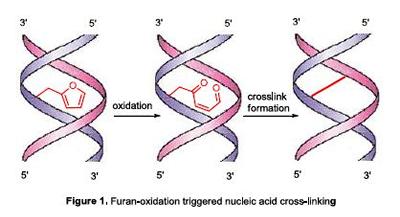Furan Modified Nucleosides and Amino acids: A Toolbox for Crosslinking, Seminar
- Time:
- 14:00
- Date:
- 21 May 2014
- Venue:
- Room 2001 Building 27 Chemistry Highfield University of Southampton Southampton SO17 1BJ
For more information regarding this seminar, please email Dr Jon Watts at J.K.Watts@soton.ac.uk .
Event details
Annemieke Madder presents a seminar as part of the Molecular Diagnostics and Theraputics Groups seminar series.
Chemical cross-linking is a very powerful tool for studying DNA-DNA and protein-DNA interactions. Recently, a new method for DNA interstrand cross-linking has been developed in our laboratory, which relies on the incorporation of a furan moiety as a caged reactive entity into oligodeoxynucleotides.1 These furan-modified nucleic acids form cross-links upon selective furan oxidation. The strategy is based on the
known oxidative ring opening of furan under the influence of Cytochrome P450 and the reaction of the resulting cis-butene-1,4-dial with free amino and sulfhydryl functions of biomolecules.


We here describe a series of applications of the developed probes, from nucleic acid duplex and triplex cross-linking to DNA-protein cross-linking. Whereas a duplex cross-linking approach finds applications in the antisense strategy, cross-linking with triplex forming oligonucleotides that bind in the major groove of dsDNA has potential applications in gene expression modulation and in gene targeting technologies. The methodology has also been further extended for its bidirectional use in protein – nucleic acid crosslinking (DPC),2 modifying protein or nucleic acid respectively to react with the unmodified counterpart as target. As the cross-link reaction is highly distance dependant, mapping of interaction surfaces is within
reach. Understanding the remarkable selectivity and affinity of nucleic acid binding proteins for their targets (DNA and RNA) in the complex cellular environment, which is central in the regulation and execution of biological processes, is a major challenge driven by the ambition to design novel drugs that can compete in such interactions.
We have further incorporated Furylalanine in peptides consisting of otherwise natural amino acids. These peptides have been used as a test system for selective furan-based labelling3,4 Furthermore, applications of the furan-oxidation technology in protein target identification will be discussed and illustrated

1. a) Halila, S; Velasco, T.; De Clercq, P.;Madder, A. Chemical Communications 2005, 936; b) Stevens, K.; Madder, A. Nucleosides, Nucleotides Nucleic Acids 2007, 1359; c) Stevens, K.; Madder, A. Nucleic Acids Research 2009, 1555; d) Op de Beeck, M. Madder A. JACS 2011, 133 (4), 796-807; e) Jawalekar, A.M.; Op de Beeck, M.; van Delft, F. L.; Madder, A. Chem. Commun. 2011, 47 (10), 2796; f) Stevens, K.; Claeys, D. D.; Catak, S.; Figaroli, S.; Hocek, M.;Tromp, J. M.; Schürch, S.; Van Speybroeck, V.; Madder, A.,. Chem. Eur. J. 2011, 6940; g) Op de Beeck, M. Madder A. JACS 2012, 10737; h) Carrette, L.L.G; Gyssels, E.;Loncke, J.; Madder, A. Org. Biomol. Chem., 2014, 12(6), 931-935; i) Carrette, L.L.G; Madder, A. ChemBioChem 2014, 15, 103-107.
2. Carrette, L.L.G, Morii, T.; Madder, A. Bioconj. Chem. 2013, 24(12), 2008-2014. 3. Deceuninck, A.; Madder, A. Chemical Communications 2009, 340-342.
4. Hoogewijs, K.; Buyst, D.; Winne J. M.; Martins J. C.; Madder, A. 2012, Chem. Comm. 49 (28), 2927.
Speaker information
Prof dr Annemieke Madder, Ghent University, Gent, Belgium,. Professor of Organic Chemistry